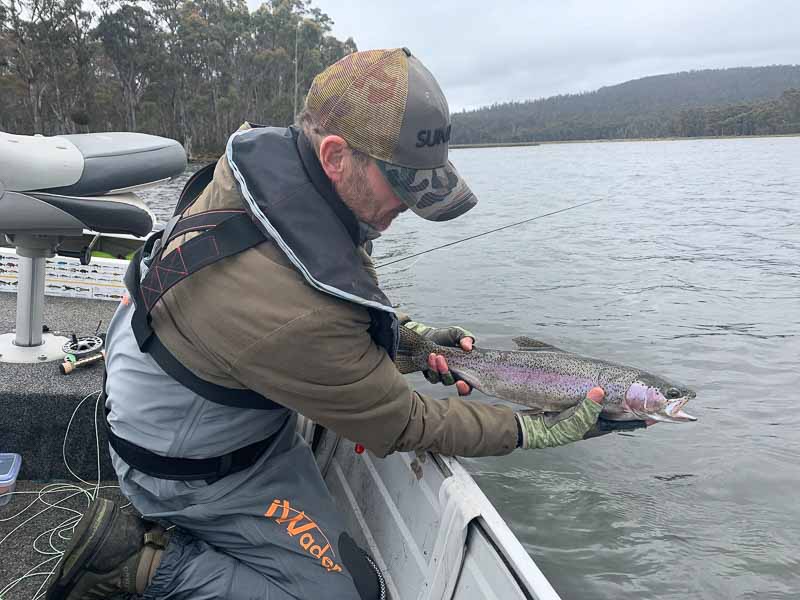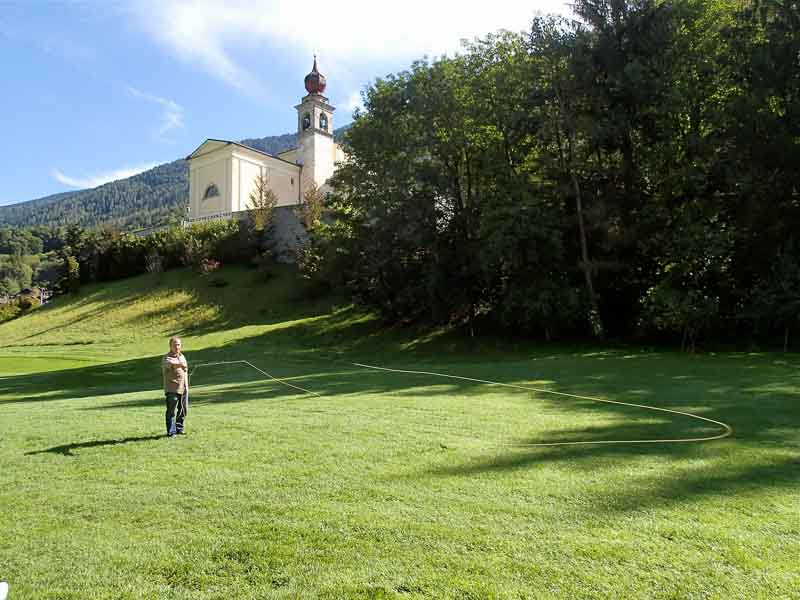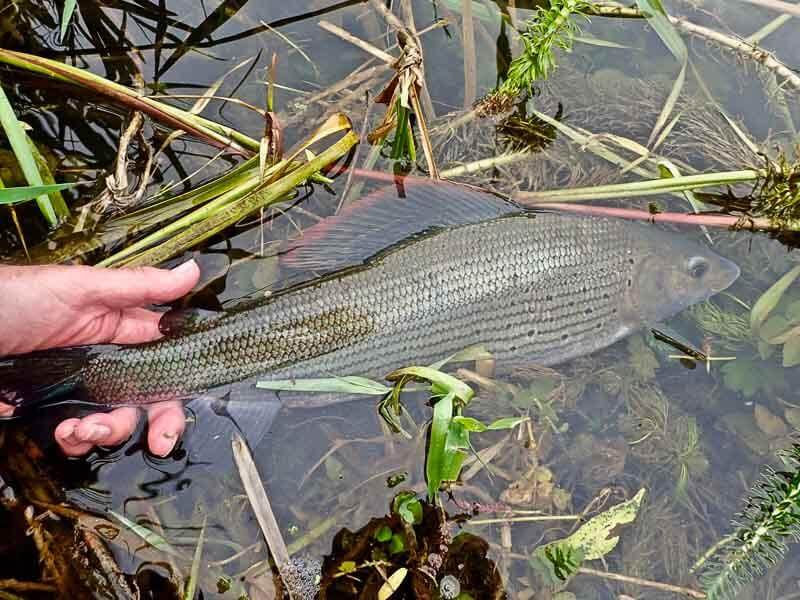Written by Jeremy Lucas
You know how I have always loved to explore the boundaries of our sport, either the edges of technique, or the places where trout are found. It has been a journey, and often it has taken me on a trajectory that has been inward looking, self-fulfilling, even self indulgent, to be frank. And sometimes it takes me out of my little world, escaping the shell, and the safe-ness. It then re-ignites my passion for this esoteric thing we do.

I had not thought it possible until my dear friend Wojtek invited me to accompany him on a visit to the Antipodes. ‘But there are snakes there,’ I complained. ‘Venomous ones, and lots of other things that want to kill me.’
‘Yes, there are, but Jezza, you are an idiot. You have family and friends there who haven’t been killed yet, and there is fishing that is like nothing you have ever known, and you need this…’
24 hours in the air, by way of a lovely stay with my family members in Sidney, getting over the pulverising effects of jet lag or whatever, and finally we arrive in Tasmania. December, summer, and I am in love again, with place, with environment, with fly fishing, right out on the ragged edge of what is possible. Among the last of what we have left on Earth, that is worthwhile. Really, that is how it is. It gets me when our friend Garth Jackson drives us out of the lowlands and up onto the plateau. Another world. You might have heard stories. Myths? No, they’re all true, and more. Primordial landscape, forest, open vistas, and water, water, water, from lagoons you can walk around in an hour to inland seas like Great Lake, where there is a lifetime of possibilities for you and for me

We are staying at Miena on the shores of Great Lake, with Craig Coltman in his ‘shack’, along with other travellers. It is a busy time, because apart from the usual fly fishing visitors (really, just about the only visitors are fly fishers) there are a few more than usual because of the World Fly Fishing Championships taking place at the beginning of our stay.
This is summer, right? Up in the Tasmanian Central Highlands. So, I have with me a nine foot four weight, and a Presentation line to match. Oh, a spool of 0.14mm and a few (just a few) flies, mostly dries, and Line Slik which I can use for flotant and to ease the sun- and wind-dried skin. I borrow some waders and outer clothing (because the weather ranges from zero degrees and snow showers, up to mid twenties, in a single day). Not much else, though my pals are looking after me. Most visitors will lean towards seven weights, which are fine, but in truth unnecessary. On the rivers, I really would stick with a three or four weight, and on the lakes, perhaps the ideal would be a 10’ four weight. I use some six and seven weights that are at Miena, for visiting guests to use, and they are fine; but are they better than my four weight, for these spectacular wild fish? Nope.

One thing though. The 0.14mm. This is alright on the rivers, at least on those we fish, but on the lakes, I strongly recommend upping it to 0.16mm, at least. Breaking on three fish during my visit, even on the four weight. Next time, this won’t happen.
You see, the fish are big, and wild. In the summer time they are looking upwards, and come readily to dry fly, and so you will see most of them; but even so, you set the hook and, naturally, they go berserk. Like one of the fish that comes, and goes, on Penstock lagoon. I see it sixty metres down-drift, and know it is on the track of my flies (a brown hopper and a possum dun), but even though I see it snaffle down the dun, and have anticipated the rise, I lift, set the hook and with an impossible surge the fish breaks me. Ten seconds later I see it jump a hundred metres off to our right. And twice more, farther off, until it sheds the hook

You don’t have to, but you can fish dry all the time here. So, why wouldn’t you? The surface is what grips me, on the high lakes. It is true that I dabble with nymphs on the extraordinary rivers on the lowland plain, and I could write masses about this; but what really captures my imagination, and it would yours, are the lakes, where the trout are looking up at the surface, at the duns. Angels dance upwards. My companions enjoy themselves with nymph, and even forays with streamer during the not infrequent storms that drive in across the Tasman Sea from Antarctica, ferocious over the plateau. But there is shelter to be found at the top of the wind, and under the cover of the impenetrable forests of gum trees. I am never without hope that fish will come to the dries. Actually, I think dry fly is ideal here, as in any place in the world, during summer, where there are trout feeding on or close to the surface.
Cloud is usually what you want, of course, because the sun is strong here. While China does what it does and pours out God knows what to destroy the ozone, the layer is holding its own and might even be repairing; but the sky looks a deep blue up on the plateau at 1,000 metres. The atmosphere does not offer much shelter and Wojtek turns into a lobster one day when he takes a siesta in the boat.
I say usually, but not always. Out on the western lakes, which are huge, shallow, and remarkably clear water, you can ‘polaroid’ the fish. You wade or drift the shoreline, watching for cruising trout. They come, anyway, to a static dry, but sometimes we see them coming, from a long way off and it is thrilling. You will miss many of them, because you react too soon. You just cannot believe that they will just keep on coming, until they have engulfed your fly and turned away. In harsh sunlight of the plateau summer, you see it all in high resolution. It redefines the thrill of fly fishing. I delight in the company of Wojtek, and guided by Martin Droz, the Czech ex-World champion, in the surreal environment of a remote lake, where you can see everything, and finally it is the trout that comes from nowhere…
In slight folds throughout the central plateau there are countless lakes, many of them connected episodically by small streams that might be dry in summer. Brown trout are found everywhere, and many of the lakes also hold rainbows. Wild rainbows, and they are not really comparable with anything we have in Britain, except perhaps for the well naturalised fish of the big reservoirs such as Grafham and Rutland. Then again, they react to surface flies in exactly the same way.
We visit Dee lagoon, a big lake divided into three by channels almost blocked by long flooded eucalypts. Garth steers us carefully through the timber until we are in the smallest of the three lakes, at the head of which is an extensive shallow area almost completely surrounded by forest. The wind, which seems relentless across most of the plateau is slight here and we notice swallows and martins swooping off a calm headland. The birds betray the duns (which, at first, are otherwise invisible to us), and the inevitability of trout feeding on them. Even before Garth cuts the engine, I see the first rises. What follows is half a dozen drifts in fly fishing paradise, and each fish that comes to my bedraggled brown hopper is a rainbow, all with tails like blades, scything away on long runs, two of them unstoppable.
How can I be gifted this? And how did it take me more than fifty years with a fly rod to discover this extraordinary place, with its unique wildlife, mile after mile of space, and thousands of lakes? And fish that have naturalised and colonised in the New World and seem to have a brighter future than does their ancestral Old World origins.
There is something else I have to do, or really, really want to do, other than fish on as many of those lakes as possible. They call it ‘shark’ fishing and they do it mostly on Great Lake (think about fifty Rutland Waters all in one). The wind must be up, with big rolling waves, and the sun must shine. Best of all the duns will be hatching. You cast a dry fly and start skating it (it’s not static dry fly!). And the trout appear through the walls of the waves, like Great Whites homing on their prey. So, I am scheming all the time, trying to persuade my wife to come with me on a return trip. Anyway, I saw only three snakes, all venomous tigers, although I nearly trod on one of these and that was indeed a very scary moment. Other than that I felt safer than I do anywhere else in the world, with the possible exception of rural France. There are so few people, and everyone is so very friendly. Ultimately, though, it is the fly fishing - the lake dry fly fishing. Angels dance upwards.
































